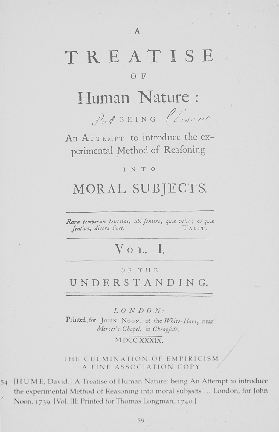
|
SLIDE 22: TITLE PAGE OF HUME - "A TREATISE OF HUMAN NATURE"
Hume argued convincingly
that the WHY is not merely
second to the HOW, but that the WHY is totally superfluous as
it is subsumed by the HOW.
|
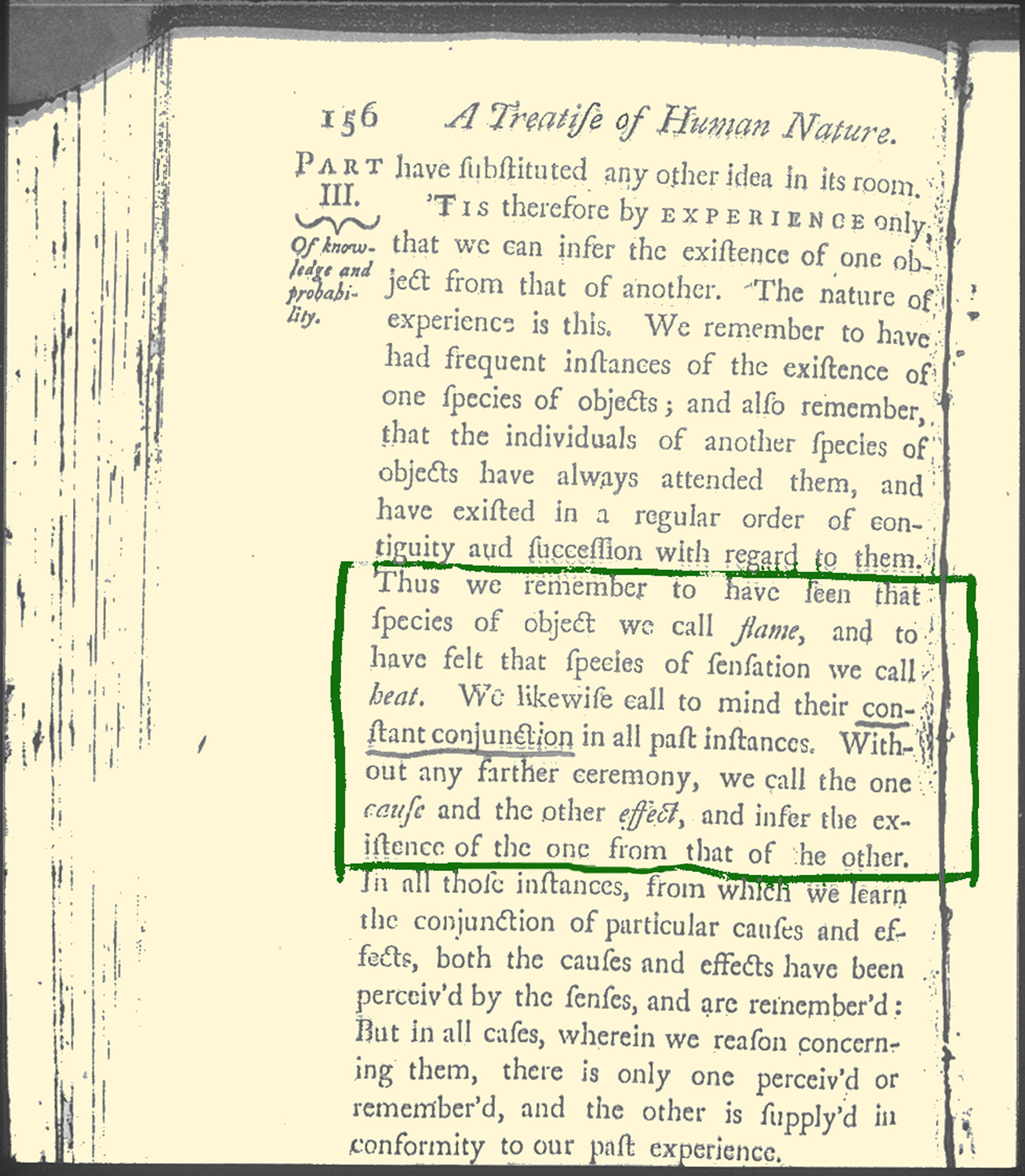
|
SLIDE 23: PAGE 156 FROM "A TREATISE OF HUMAN NATURE"
On page 156 of Hume's "Treatise of Human Nature", we find the
paragraph that shook up causation so thoroughly that it
has not recovered to this day.
I always get a kick reading it:
"Thus we remember to have seen that species
of object we call *FLAME*, and to have felt
that species of sensation we call *HEAT*. We
likewise call to mind their constant conjunction in
all past instances. Without any farther ceremony,
we call the one *CAUSE* and the other *EFFECT*,
and infer the existence of the one from that of the
other."
Thus, causal connections according to Hume are
product of observations. Causation is a learnable
habit of the mind,
almost as fictional as optical illusions and as
transitory as Pavlov's conditioning.
It is hard to believe that Hume was not aware of the
difficulties inherent in his proposed recipe.
He knew quite well
that the rooster crow STANDS in constant conjunction to the
sunrise, yet it does not CAUSE the sun to rise.
He knew that the barometer reading STANDS in constant
conjunction to the rain, but does not CAUSE
the rain.
|
Today these difficulties fall under the rubric of
SPURIOUS CORRELATIONS, namely "correlations that do not imply causation".
Now, taking Hume's dictum that
all knowledge comes from experience, that experience
is encoded in the mind as correlation, and
our observation that correlation does
not imply causation, we are led into
our first riddle of causation:
How do people EVER acquire knowledge of CAUSATION?
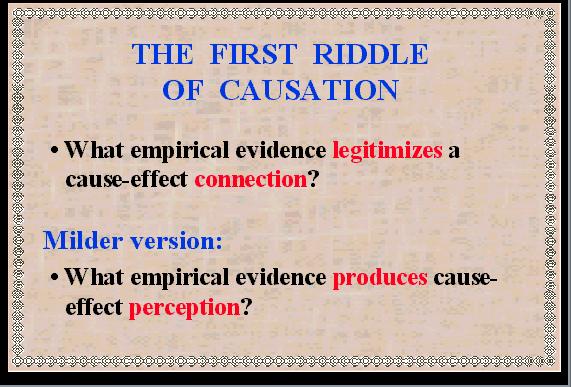
|
SLIDE 24: THE FIRST RIDDLE OF CAUSATION
We saw in the rooster example that regularity of succession
is not sufficient; what WOULD be sufficient?
What patterns of experience would justify calling
a connection "causal"?
Moreover: What patterns of experience
CONVINCES people that a connection is "causal"?
|
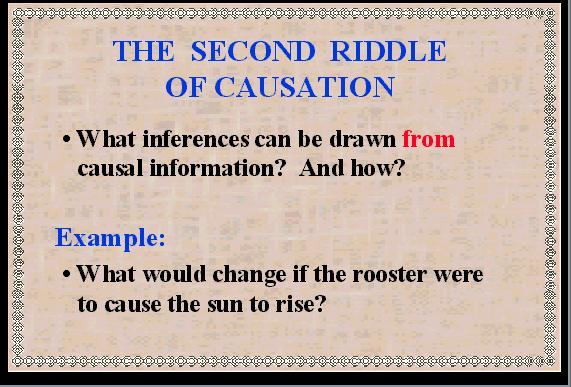
|
SLIDE 25: THE SECOND RIDDLE OF CAUSATION
If the first riddle concerns the LEARNING
of causal-connection, the second
concerns its usage:
What DIFFERENCE does it make if I told you
that a certain connection is or is not causal:?
Continuing our example, what difference does it make
if I told you that the rooster does cause the sun to rise?
This may sound trivial.
The obvious answer is that knowing what causes what
makes a big difference in how we act.
If the rooster's crow
causes the sun to rise we could make the
night shorter by waking up our rooster earlier and make him
crow - say by telling him the latest rooster joke.
|
But this riddle is NOT as trivial as it seems.
If causal information has an empirical meaning
beyond regularity of succession, then that information
should show up in the laws of physics.
But it does not!
The philosopher Bertrand Russell made this argument in 1913:
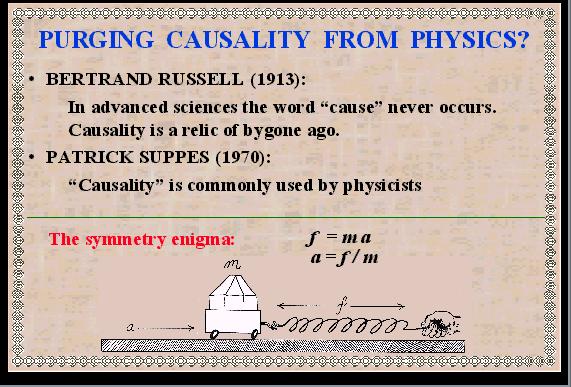
|
SLIDE 26: PURGING CAUSALITY FROM PHYSICS?
"All philosophers, "says Russell," imagine that
causation is one of the fundamental axioms of
science, yet oddly enough, in
advanced sciences, the word 'cause' never occurs ... The law of
causality, I believe,
is a relic of bygone age,
surviving, like the monarchy, only because it is
erroneously supposed to do no harm ..."
Another philosopher, Patrick Suppes, on the other hand,
arguing for the importance of causality, noted that:
"There is scarcely an issue of *PHYSICAL REVIEW*
that does not contain at least one article
using either `cause' or `causality' in its title."
|
What we conclude from this exchange is that
physicists talk, write, and think one way and formulate
physics in another.
Such bi-lingual activity would be forgiven if causality
was used merely as a
convenient communication device - a shorthand for expressing
complex patterns of physical relationships
that would otherwise take many equations to write.
After all! Science is full of abbreviations:
We use, "multiply x by 5", instead of "add x
to itself 5 times"; we say: "density" instead of
"the ratio of weight to volume".
Why pick on causality?
"Because causality is different," Lord Russell would argue,
"It could not possibly be an abbreviation,
because the laws of physics are all symmetrical, going both ways,
while causal relations are uni-directional, going from cause to effect."
Take for instance Newton's law
f = ma
The rules of algebra permit us to write this law
in a wild variety of syntactic forms, all meaning
the same thing - that if we know any two of the three quantities,
the third is determined.
Yet, in ordinary discourse
we say that force causes acceleration - not that
acceleration causes force, and we feel very strongly
about this distinction.
Likewise, we say that the ratio f/a helps us DETERMINE
the mass, not that it CAUSES the mass.
Such distinctions are not supported by the
equations of physics, and this leads us to ask whether
the whole causal vocabulary is purely
metaphysical.
"surviving, like the monarchy...etc."
Fortunately, very few physicists paid attention to Russell's enigma.
They continued to write equations in the office
and talk cause-effect in the CAFETERIA, with
astonishing success, they smashed the atom, invented the transistor,
and the laser.
The same is true for engineering.
But in another arena the tension could not go
unnoticed, because in that arena the demand for
distinguishing causal from other relationships was very
explicit.
This arena is statistics.
The story begins with the discovery of correlation,
about one hundred years ago.
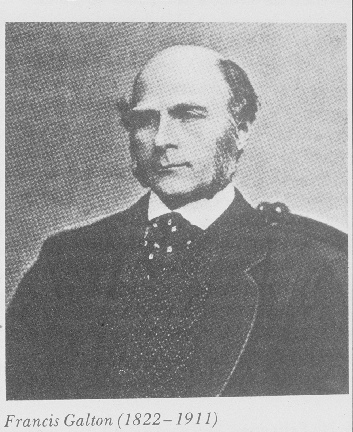
|
SLIDE 27: FRANCIS GALTON (PORTRAIT)
Francis Galton, inventor of fingerprinting and cousin
of Charles Darwin, quite understandably set out to
prove that talent and virtue run in families.
|
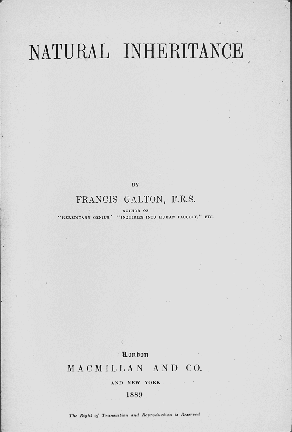
|
SLIDE 28: TITLE PAGE "NATURAL INHERITANCE"
These investigations, drove Galton to consider various ways of
measuring how properties of one class of individuals or objects are
related to those of another class.
|
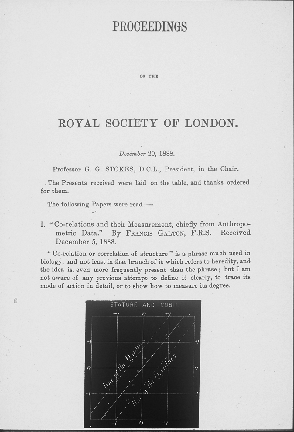
|
SLIDE 29: GALTON'S PLOT OF CORRELATED DATA (1888)
In 1888, he measured the length of a person's forearm and the
size of that person's head and
asked to what degree
can one of these quantities predict the other.
He stumbled upon the following discovery: If you
plot one quantity against the other
and scale the two axes properly,
then the slope of the best-fit line has some nice mathematical
properties:
The slope is 1 only when one quantity can predict
the other precisely; it is zero whenever the prediction
is no better than a random guess and, most remarkably, the slope
is the same no matter if you plot X against Y or Y against X.
"It is easy to see," said Galton, "that co-
relation must be the consequence of the variations of
the two organs being partly due to common causes."
Here we have, for the first time, an objective measure
of how two variables are "related" to each other, based strictly
on the data, clear of human judgment or opinion.
|
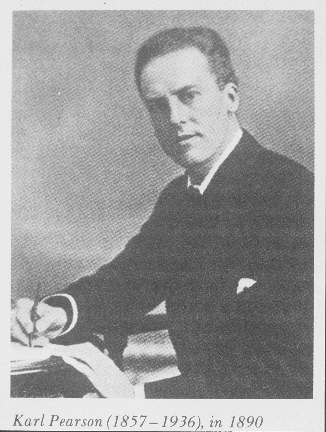
|
SLIDE 30: KARL PEARSON (PORTRAIT, 1890)
Galton's discovery dazzled one of his students, Karl Pearson, now
considered the founder of modern statistics.
Pearson
was 30 years old at the time, an accomplished physicist
and philosopher about to turn lawyer, and this is how he describes,
45 years later, his initial reaction to Galton's discovery:
|
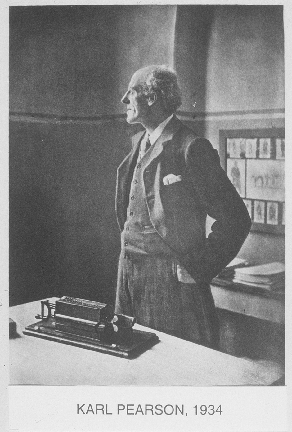
|
SLIDE 31: KARL PEARSON (1934)
"I felt like
a buccaneer of Drake's days -...
I interpreted that
sentence of Galton to mean that there was a category
broader than causation, namely correlation, of which
causation was only the limit, and that this new
conception of correlation brought psychology,
anthropology, medicine, and sociology in large parts
into the field of mathematical treatment."
Now, Pearson has been described as a person "with the kind of drive and
determination that took Hannibal over the Alps and
Marco Polo to China."
When Pearson felt like a buccaneer, you
can be sure he gets his bounty.
|
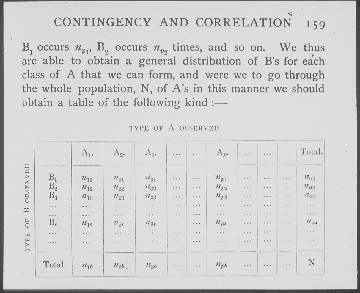
|
SLIDE 32: CONTINGENCY TABLE (1911)
1911 saw the publication of
the third edition of his book "The Grammar of Science".
It contained a new chapter titled
"Contingency and correlation - the insufficiency of
causation," and this is what Pearson says in that chapter:
"Beyond such discarded fundamentals as 'matter' and 'force' lies
still another fetish amidst the inscrutable arcana of modern science,
namely, the category of cause and effect."
|
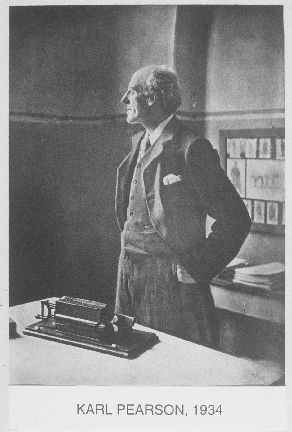
|
SLIDE 33: KARL PEARSON (1934)
Thus, Pearson categorically denies the need for an
independent concept of causal relation beyond
correlation.
He held this view throughout his life and,
accordingly, did not mention causation in
ANY of his technical papers.
His crusade against animistic concepts such as "will" and "force"
was so fierce and his rejection of determinism so absolute that he
EXTERMINATED causation from statistics before it had
a chance to take root.
|
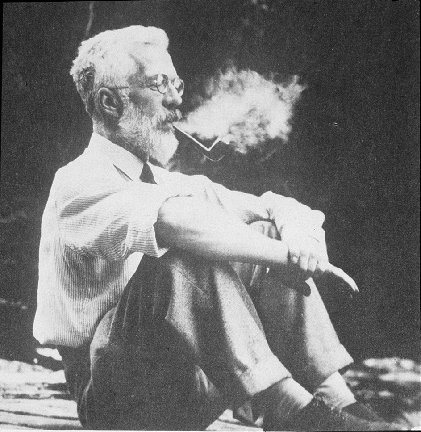
|
SLIDE 34: SIR RONALD FISHER
It took another 25 years and
another strong-willed person, Sir Ronald Fisher, for
statisticians to formulate the randomized experiment - the
only scientifically proven method of testing causal
relations from data, and which is, to this day, the one and only causal concept
permitted in mainstream statistics.
And that is roughly where things stand today...
If we count the number of doctoral theses, research
papers, or textbooks pages
written on causation, we get the impression that Pearson still
rules statistics.
The "Encyclopedia of Statistical
Science" devotes 12 pages to correlation but only 2
pages to causation, and spends one of those pages
demonstrating that "correlation does not imply
causation."
Let us hear what modern statisticians say about causality
|
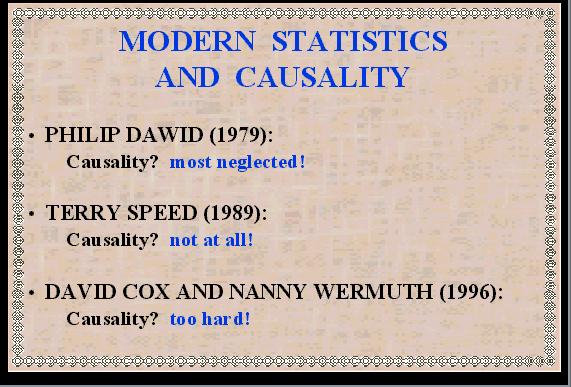
|
SLIDE 35: MODERN STATISTICS AND CAUSALITY
Philip Dawid , the current editor of Biometrika-the
journal founded by Pearson - admits:
"causal inference is one of the most important, most
subtle, and most neglected of all the problems of
statistics".
Terry Speed, former president of the Biometric Society
(whom you might remember as an expert witness at the
O.J. Simpson murder trial),
declares: "considerations of causality
should be treated as they have always been treated in
statistics: preferably not at all, (but if necessary, then
with very great care.)"
Sir David Cox and Nanny Wermuth,
in a book published just a few months ago, apologize as follows: "We did
not in this book use the words CAUSAL or CAUSALITY....
Our reason for caution is that it is rare that firm
conclusions about causality can be drawn from one
study."
|
This position of caution and avoidance has paralyzed many fields
that look to statistics for guidance, especially economics and social science.
A leading social scientist stated in 1987:
"It would be very healthy if more researchers
abandon thinking of and using terms such as
cause and effect."
Can this state of affairs be the work of just
one person? even a buccaneer like Pearson?
I doubt it.
But how else can we explain why statistics, the field that
has given the world such powerful concepts as
the testing of hypothesis and the design of experiment
would give up so early on causation?
One obvious explanation is, of course,
that causation is much harder to measure than
correlation.
Correlations can be estimated directly
in a single uncontrolled study, while causal conclusions
require controlled experiments.
But this is too simplistic;
statisticians are not easily deterred by difficulties and
children manage to learn cause effect relations
WITHOUT running controlled experiments.
The answer, I believe lies deeper,
and it has to do with the official language
of statistics, namely the language of probability.
This may come as a surprise to some of you but
the word "CAUSE" is not in the vocabulary of probability theory;
we cannot express in the language of probabilities the sentence,
"MUD DOES NOT CAUSE RAIN" - all we can say is that the two
are mutually correlated, or dependent - meaning if we find one,
we can expect the other.
Naturally, if we lack a language to express a certain concept
explicitly, we can't expect to develop scientific activity
around that concept.
Scientific development requires that knowledge be transferred
reliably from one study to another and, as Galileo has shown
350 years ago, such transference requires the precision
and computational benefits of a formal language.
I will soon come back to discuss the importance of
language and notation, but first,
I wish to conclude this
historical survey with a tale from another field in
which causation has had its share of difficulty.
This time it is computer science - the science of
symbols - a field that is relatively new, yet it has
placed a tremendous emphasis on language and notation and,
therefore, may offer a useful
perspective on the problem.
When researchers began to encode causal
relationships using computers, the two riddles of
causation were awakened with renewed vigor.
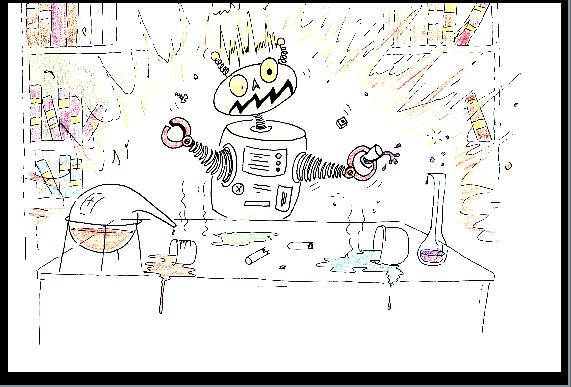
|
SLIDE 36: ROBOT IN LAB
Put yourself in the shoes of this robot who is trying to
make sense of what is going on in a kitchen or a
laboratory.
Conceptually, the robot's problems are the
same as those faced by an economist seeking to model the National debt
or an epidemiologist attempting to
understand the spread of a disease.
Our robot,
economist, and epidemiologist all need to track down
cause-effect relations from the environment, using
limited actions and noisy
observations.
This puts them right at Hume's first
riddle of causation: HOW?
|
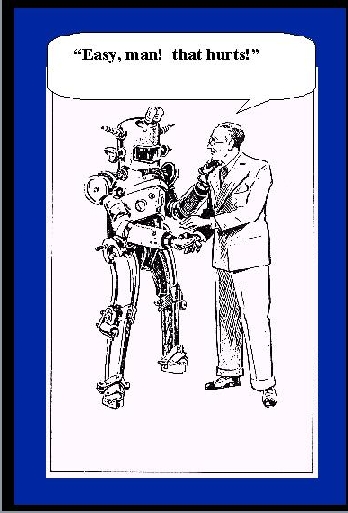
|
SLIDE 37: ROBOT WITH MENTOR
The second riddle of causation also plays a role in the
robot's world.
Assume we wish to take a shortcut and
teach our robot all we know about cause and
effect in this room.
How should the robot organize and
make use of this information?
Thus, the two philosophical riddles of causation are
now translated into concrete and practical questions:
|
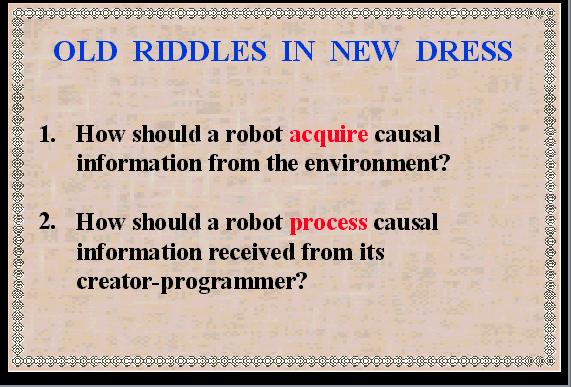
|
SLIDE 38: OLD RIDDLES IN NEW DRESS
How should a robot acquire causal information
through interaction with its environment?
How should a robot process causal information
received from its creator-programmer?
Again, the second riddle is not as trivial as it might
seem. Lord Russell's warning that causal relations and
physical equations are incompatible now surfaces as an
apparent flaw in logic.
|
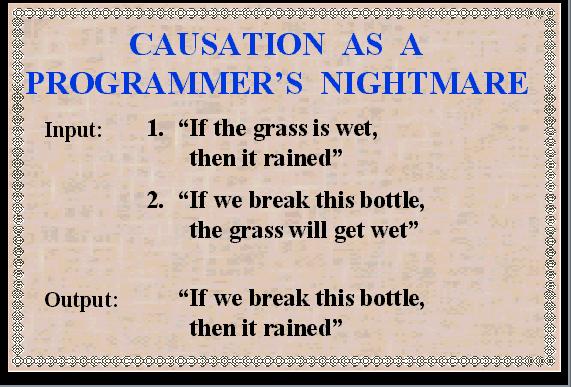
|
SLIDE 39: CAUSALITY: A PROGRAMMER'S NIGHTMARE
For example, when given the information, "If the grass
is wet, then it rained" and "If we
break this bottle, the grass will get wet," the
computer will conclude "If we break this bottle, then
it rained."
The swiftness and specificity with which such programming
bugs surface, have made Artificial-Intelligence programs an ideal laboratory
for studying the fine print of causation.
|
Continue
with Part 2

